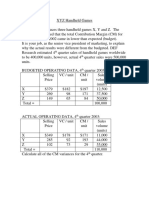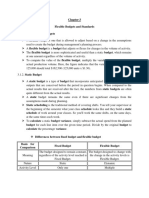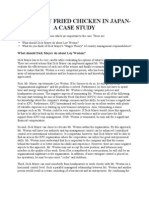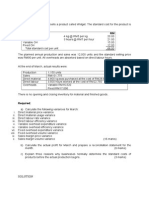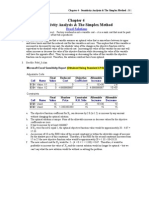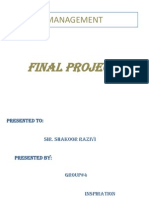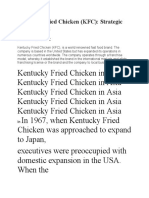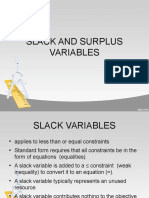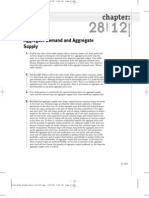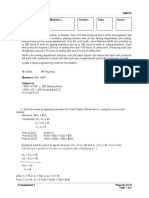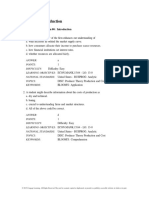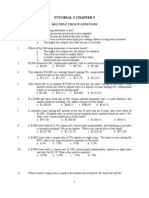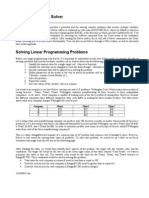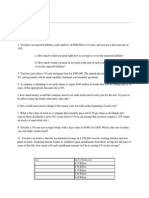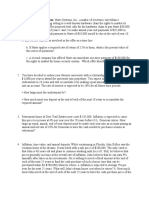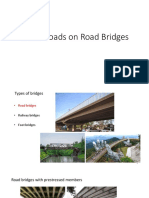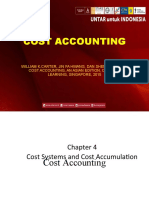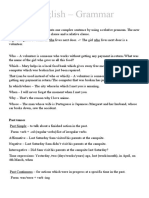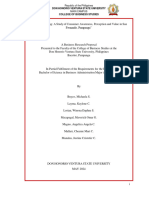Homework Assignment 1 Key
Homework Assignment 1 Key
Uploaded by
metetezcanCopyright:
Available Formats
Homework Assignment 1 Key
Homework Assignment 1 Key
Uploaded by
metetezcanCopyright
Available Formats
Share this document
Did you find this document useful?
Is this content inappropriate?
Copyright:
Available Formats
Homework Assignment 1 Key
Homework Assignment 1 Key
Uploaded by
metetezcanCopyright:
Available Formats
INDIVIDUAL HOMEWORK ASSIGNMENT KEY- Due December 5th, 2013
AD576
Please send your solutions to Bahar Koseolu at bahar.koseoglu@boun.edu.tr
1.You just turned 25 and have been saving for an around-the-world vacation. You want to take trip to celebrate your 30th birthday. You have set aside, as of today, $15,000 for such a trip. You expect the trip will cost $25,000. The financial instruments you have invested the $15,000 in have been earning, on average, about 8%. (You may ignore income taxes.) a. Will you have enough money in that vacation account on your 30th birthday to take the trip? What will be the surplus, or shortfall, in that account when you turn 30? (8 points) Years: Your age: Today 1 2 3 4 5 35 36 37 38 39 40 l---------l---------l---------l---------l---------l $15,000 ?
This scenario presents the task of determining the FV of a single lump sum in five years in an 8% interest rate environment. So, we obtain $22,039.50 (1.4693 $15,000) as the future value as of your 30th birthday. It is $2,960.50 short of the projected needed amount of $25,000. b. If you had to, you could further fund the trip by making, starting today, and five annual $500 contributions to account. If you adhered to such a plan, how much will be in the account on your 30th birthday? (8 points) Years: Your age: Today 1 2 3 4 5 35 36 37 38 39 40 l---------l---------l---------l---------l---------l $500 $500 $500 $500 $500 ?
This scenario posits a series of cash flows as additional investments into your vacation savings account for five-years. The resulting amount is $3,168.00, which, when added to the $22,039.50 from the (a) scenario above, leads to the insight that, as of your 30th birthday, there will now be sufficient funds in the account. Indeed, the account will have $25,207.50 ($22,039.50 + $3,168) in it. 2. On December 20, 1994 the Nippon Telegraph & Telephone Corporation (NTT) issued 1 billion of 10 year debentures due December 20, 2004. The debentures carried a 4.75% coupon. They were priced at par, that is, they cost the investor 1000. The entire amount of borrowed principal would be repaid at maturity. Interest would be paid annually upon the anniversary date of the issuance (i.e., on December 20th of each year). The debentures carried an AAA credit rating.
a. What was the yield to maturity of NTTs debenture at the time of issuance? What would it have been if the bonds were priced at 99 instead 100 (i.e., at 99% of face value)? at 101 instead of 100? (8 points)
r=4.75% The follow-up questions about what the yield would have been had the bonds been priced at 99 od 101 instead of 100 illustrates the inverse relationship between price and yield for fixed-income securities. b. By 1996 yields on AA yen debt maturing in 8 years had dropped to 3.00%. Given this yield to maturity, at what price should the NTT debentures have been selling? (8 points) If the above equation has been put on the front board, it is a simple matter to modify it to appear as follows
The new price is 112.28. 3. A prospective homeowner wants to determine how much she can borrow in form of a fixed-rate 20year mortgage. Mortgages of that maturity carry a fixed interest rate of 9.00%. She estimates that she can afford annual, pre-tax payments (interest plus principal) on her mortgage of $25,000 (for simplicity, assume that mortgage payments are made once a year at the end of the year). a. How large a mortgage can she afford, assuming she makes steady payments of $25,000 per year for 20 years? How much total interest will be paid over the 20-year life of the mortgage? How much interest will be paid during the first year of the mortgage? How much principal will be paid in the first year? How much of the final $25,000 payment at the end of 20 years will be interest and how much will be principal? (8 points) This part is a simple present value problem. If priced to yield 9% over 20 years, the value of a mortgage requiring $25,000 annual payments for 20 years is $228,214. Since the borrower will ultimately pay $500,000 in total over 20 years, the total interest paid will be $271,786 (= $500,000 - $228,214). In the first year of the mortgage, interest paid will be $20,539 (= .09 $228,214). It follows that principal repayment is $4,461 (= $25,000 - $20,539). After 19 years of payments, the borrower will have repaid $205,278 of principal. Therefore, final payment will consist of $22,936 of principal and $2,064 of interest. This difference relative to the first years payments illustrates the changing proportions of principal and interest in level payments on amortizing debt. b. Suppose the prospective homeowner expects her income to grow such that she could afford $25,000 per year of total debt service in the first five years of a 20-year mortgage, $30,000 per year in
the second five years, $35,000 in the third five years, and $40,000 in the last five years. How large a mortgage at 9.00% could she afford under these circumstances? (8 points) Discounting these cash flows to the present using a 9% discount rate provides a value of $273,302. 4. Mr. and Mrs. Brown purchased a $35,000 house 20 years ago. They took a 30-year mortgage for $30,000 at a 3% annual interest rate. Their bank has recently offered the couple two alternatives by which they could prepay their mortgage. The Browns have just made their 20th annual payment. Which of the following two alternatives, if either, should the Browns pursue? a. The couple could prepay their mortgage at a 30% discount from the current principal outstanding while the current 10-year mortgage rates are 12%. Assume payments are made at the end of each year (instead of monthly). (You should compare the actual single payment the couple needs to make to the bank with the PV of the remaining payments) (8 points) The annual payment for the 3%, 30-year, $30,000 mortgage is $1,530.58: PV= 30000, r= 3%, N= 30 => PMT= 1,530.58 The 30% discount payoff offer Calculate the balance of the mortgage with 10 years remaining, i.e., calculate the 3% mortgage balance with ten annual payments of $1,530.58 to be $13,056.14: N: 10, r= 3% and PMT = 1,530.58 => PV= 13,056.14 The only point in computing the remaining balance above is to calculate the mortgage payoff amount if the Browns get a 30% discount from this $13,056.15 remaining balance: Payoff Now = (100% - 30%) $13,056.15 = $9,139.30 Alternatively, the Browns could pay off the mortgage as scheduled, with ten more annual payments of $1,530.58. In terms of real present values, any future payments are valued at current mortgage rates of 12% (the 3% was only used to determine the payments originally and is not tod ays discount rate for mortgage cash flows). The present value, at 12%, f the ten remaining $1,530.58 payments is $8,648.12. r= 12%, N= 10, PMT = 1,530.58 => PV = 8,648.12 Actually, since the cash flows are negative (outflows) here, the present value is negative, $8,648.12, or equivalently, a present cost of $8,648.12. Thus, the Browns can either pay out a stream of ten payments which, at todays rates, would be like paying out $8,648 today; or they can choose to take the banks offer and pay out $,139 in cash right now. The banks offer has a $491 higher present cost to the Browns, or a $491 lower present values they keep their low interest mortgage and save $491 in present value by turning down the banks offer. b. The couple could replace their existing mortgage with a five-year zero-interest loan, in the amount of their current mortgages principal outstanding. This new loan was to be repaid in 5 equal annual
payments. The banker pointed out that this option would save them well over $2,000 in interest. .(You should follow a similar strategy to part a) (8 points)
The five-year zero-interest loan The second alternative seems even more enticing. The no-interest 5year loan splits the $13,056.14 remaining principal balance into five equal payments of $2,611.23. The ten remaining payments of $1,530.58 under the 3% mortgage add up to a total outflow of $15,305.80, of which $13,056.14 is current principal, leaving $2,249.66 that must be interest. This is the number behind the bankers mention of over $2,000 in interest savings. Take the same approach here calculate the present cost of the alternatives. We have already calculated the present cost of the existing mortgage payments to be$8,648. The calculation of the present cost of the no-interest alternative gives a $9,413 result: r= 12%, N= 5, PMT= 2611.23 => PV= 9,412.90 Thus, this alternative is actually the worst of the three options! Even though there is no interest paid, the $13,056 is paid back so fast that the interest saved over that short period (12% over 5 years) is not very significant; the present cost is still high. But with ten years of low interest, we get most of the savings, but over twice the period (9% savings over 10 years). The present cost of the 10 -year 3% mortgage is almost $800 lower. 5. You are the CFO of Etox Motor Company. The board has decided to offer an early retirement plan whereby the typical 55-year-old worker can retire now with a small cash severance and draw a pension of $10,000 a year, expected to last for 30 years (the first payment would be made one year from now). You plan to set aside sufficient money now to fund the plan and have secured guarantees from your insurance company promising you an 8% annual return on all funds deposited by you, to meet these projected payments based on the terms above, and to bear any risk (such as interest-rate surprises or greater-than-expected lifespans). You expect 100 workers to take advantage of the plan, so you must fund expected pension payouts of $1 million a year for 30 years. The workers have objected to plan, since the pension payments lose purchasing power over time due to inflation. They propose an alternative plan of an $8,000 pension (also beginning in a year) that grows each year at a fixed rate 5%. They claim that this plan should be attractive to the company, since it needs to pay less money to pensioners ($8,000 vs. $10,000) during todays difficult economic times. Which plan do you choose? (10 points) We need to pay enough to the insurance company to fund a $1 million payout every year for 30 years, at an annual rate of 8%. The present value of these payments at that rate is $11,257,783.
Alternative plan is an annuity starting out at $.8 million and then growing at 5% per year. Using the formula for a growing annuity, the present value (present cost to us) of the payments is $15,213,250:
Obviously the growth feature adds a great deal of cash flow commitment to the payouts we must fund, and is too expensive an alternative at these terms, costing us about $4 million extra. 6. Paint and More (PM) is considering the purchase of a paint-mixing machine to reduce labor costs. The savings are expected to result in additional cash flows of $5,000 per year. The machine costs $35,000 and is expected to last for 15 years. PM has determined that the cost of capital for such an investment is 12%. a. Compute the net present value (NPV). Should PM purchase the machine? Assume that all cash flows (except the initial purchase) occur at the end of the year, and do not consider taxes. (6 points) 5 5 5 5 5 5 5 5 5 5 5 5 5 5 5 -35 Discounting this 15-year annuity to its present value at a 12% annual discount rate gives a present value of $34,054. Combining this with the initial investment cash flow of -$35,00, the NPV is $946. PM should not purchase the machine. b. For a $5000 per year additional expenditure, PM can get a Good as New service contract that essentially keeps the machine in new condition forever. Net of the cost of the service contract, the machine would then produce cash flows of $4,400 per year in perpetuity. Should PM purchase the machine with the service contract? (6 points) The time line of cash flows relevant to Part B differs from those above in two way. First, the cash flows are reduced from $5,000 to $4,400. Second, the cash flows (previously an annuity) are now a perpetuity. TimeLine of Cash Flows: 4.4 -35 The present values of the positive cash flows here is $36,667, using the perpetuity valuation formula. Thus, the NPV equals $1,667, and we would purchase the machine with the service contract (if it were not for the better deal presented in Part C). 4.4 4.4 4.4 4.4 4.4 4.4 4.4 .........
c. Instead of the service contract, PM engineers have devised a different option to preserve and actually enhance the capability of the machine over time. By reinvesting 20% of the annual cost savings back into new machine parts, the engineers can increase the cost savings at a4% annual rate. For example, at the end of the year one, 20% of the $5,000 cost savings ($1,000) is reinvested in the machine; the net cash flow is thus $4,000. Next year, the cash flow from cost savings grows by 4% to $5,200 gross, or $4,160 net, of the 20% reinvestment. As loans as the 20% reinvestment continues, the cash flows continue to grow at 4% in perpetuity. What should PM do? (6 points) The problem in Part C shows the important effect of growing cash flows on valuation. The time line with the growing (net) cash flows is shown. Note that it is not necessary to calculate any cash flows other than the first, since they are growing at a constant 4% rate. 4 -35 4.16 4.33 450 4.68 487 5.06 5.26 grow @ 4% ..........
Using the standard formula, the value of the growing perpetuity is $50,000, so the NPV is $15,000:
Because this investment has a positive NPV and it is better than the other positive NPV investment, the company should accept it. 7. Suppose a firm is expected to increase dividends by 20% in one year and by 15% in two years. After that dividends will increase at a rate of 5% per year indefinitely. If the last dividend was $1 and the required return is 20%, what is the price of the stock? (8 points) Compute the dividends until growth levels off: D1 = 1(1.2) = $1.20 D2 = 1.20(1.15) = $1.38 D3 = 1.38(1.05) = $1.449 Find the expected future price: P2 = D3 / (R g) = 1.449 / (0.2 - 0.05) = 9.66 Find the present value of the expected future cash flows: P0 = 1.20 / (1.2) + (1.38 + 9.66) / (1.2)2 = 8.67
You might also like
- FM11 CH 11 Mini CaseDocument13 pagesFM11 CH 11 Mini CasesushmanthqrewrerNo ratings yet
- Heizer Om13 TB MDDocument34 pagesHeizer Om13 TB MDSHANXIU WANNo ratings yet
- CCS 12 XYZ ExampleDocument1 pageCCS 12 XYZ ExampleDebasis MohantyNo ratings yet
- Chapter 5Document63 pagesChapter 5JivashiniBalasupurManiam100% (1)
- Cost-Ii CH-3 &4Document108 pagesCost-Ii CH-3 &4Hayelom Tadesse GebreNo ratings yet
- GG Toys CalculationDocument6 pagesGG Toys CalculationGayathri Murugesan100% (1)
- Numerical ExampleDocument2 pagesNumerical ExampleVishal GoyalNo ratings yet
- HW 2. Chapter 4 (3, 4, 8, 9, 10)Document10 pagesHW 2. Chapter 4 (3, 4, 8, 9, 10)VIKRAM KUMAR0% (1)
- Krugman2e Solutions CH10Document16 pagesKrugman2e Solutions CH10Ayten MajidovaNo ratings yet
- Problem Sets 15 - 401 08Document72 pagesProblem Sets 15 - 401 08Muhammad GhazzianNo ratings yet
- Kentucky Fried Chicken in JapanDocument3 pagesKentucky Fried Chicken in Japanezeasor arinzeNo ratings yet
- KFC JapanDocument10 pagesKFC JapanAnonymous 5GHZXlNo ratings yet
- Chap 10Document12 pagesChap 10Syed HamdanNo ratings yet
- VarianceDocument3 pagesVarianceWan Noor AsmuniNo ratings yet
- MCQDocument34 pagesMCQshankarNo ratings yet
- ZomatoDocument56 pagesZomatopreethishNo ratings yet
- Practice Qns - Cap StructureDocument8 pagesPractice Qns - Cap StructureSadi0% (1)
- CHAP04 SensitivityDocument30 pagesCHAP04 SensitivityQWEASDASDSNo ratings yet
- Chapter 4 Sensitivity Analysis and The Simplex Method PDFDocument14 pagesChapter 4 Sensitivity Analysis and The Simplex Method PDFUsman GhaniNo ratings yet
- Coca ColaDocument29 pagesCoca ColaSaniya MazharNo ratings yet
- Kentucky Fried Chicken Strategic ManagementDocument6 pagesKentucky Fried Chicken Strategic ManagementHarsh wadhwaNo ratings yet
- Topic 5: Mathematical ProgrammingDocument28 pagesTopic 5: Mathematical ProgrammingRuthchell CiriacoNo ratings yet
- Chap 05Document16 pagesChap 05Syed Hamdan0% (2)
- Mod BDocument32 pagesMod BRuwina Ayman100% (1)
- SlackDocument13 pagesSlackjovy velascoNo ratings yet
- Corporate Strategy Case: Group 10Document7 pagesCorporate Strategy Case: Group 10Soura DasNo ratings yet
- 7 LP Sensitivity AnalysisDocument9 pages7 LP Sensitivity AnalysiszuluagagaNo ratings yet
- 03 MS13e TB Ch03Document27 pages03 MS13e TB Ch03Asad AbbasiNo ratings yet
- Stock Valuation ProblemsDocument1 pageStock Valuation Problemstdavis1234No ratings yet
- Chap 13Document16 pagesChap 13Syed HamdanNo ratings yet
- Chapter 8 Review Questions With AnswersDocument9 pagesChapter 8 Review Questions With AnswersDiamante Gomez0% (1)
- Case Study: Look Before You Leverage: Submitted To: Mr. Johnel Fil T. ArcipeDocument8 pagesCase Study: Look Before You Leverage: Submitted To: Mr. Johnel Fil T. ArcipeWelshfyn ConstantinoNo ratings yet
- Krug2e Macro Ps Ch12Document14 pagesKrug2e Macro Ps Ch12Stephen Michael Palmer100% (3)
- Name: Fernandez, Lalaine Michicko L. Section: Date: ScoreDocument3 pagesName: Fernandez, Lalaine Michicko L. Section: Date: ScoreMich FernandezNo ratings yet
- Mankiw7e TB Ch13 (001-060)Document60 pagesMankiw7e TB Ch13 (001-060)Geraldine Rojas AmbrosioNo ratings yet
- Tutorial - 3Document4 pagesTutorial - 3danrulz18No ratings yet
- Chapter 9Document16 pagesChapter 9Benja100% (1)
- Chapter11 PDFDocument25 pagesChapter11 PDFBabuM ACC FIN ECONo ratings yet
- Chap 04Document16 pagesChap 04Syed Hamdan100% (1)
- Solver ProgrammingDocument4 pagesSolver Programmingpoopoosingh100% (1)
- Chap 06Document12 pagesChap 06Syed Hamdan50% (2)
- Krug2e Macro PS Ch10Document12 pagesKrug2e Macro PS Ch10Annie Bronowski50% (2)
- Chap009 MaDocument57 pagesChap009 MamaglennaNo ratings yet
- Case StudyDocument6 pagesCase Studyanhdu7No ratings yet
- CAF 02 CHP Wise Mcqs PDFDocument79 pagesCAF 02 CHP Wise Mcqs PDFAtta SoomroNo ratings yet
- Practise MCDocument6 pagesPractise MCNick Chow100% (1)
- Econ Old Test 2Document7 pagesEcon Old Test 2Homer ViningNo ratings yet
- Dcf-Analysis Calculator (Edit Items in Blue)Document4 pagesDcf-Analysis Calculator (Edit Items in Blue)Christopher GuidryNo ratings yet
- The Lobby Network - Big Tech's Web of Influence in The EUDocument48 pagesThe Lobby Network - Big Tech's Web of Influence in The EUJack PurcherNo ratings yet
- Anagene Case StudyDocument1 pageAnagene Case StudySam Man0% (3)
- Home Mortgage - College AlgebraDocument11 pagesHome Mortgage - College AlgebraDebalina Dass100% (1)
- Concept Check Quiz: First SessionDocument27 pagesConcept Check Quiz: First SessionMichael MillerNo ratings yet
- Week 1 - Time Value of Money - MCQDocument10 pagesWeek 1 - Time Value of Money - MCQmail2manshaa100% (1)
- University of Pennsylvania The Wharton SchoolDocument18 pagesUniversity of Pennsylvania The Wharton SchoolBassel ZebibNo ratings yet
- Assignment 1Document7 pagesAssignment 1Camilo Andres MesaNo ratings yet
- Tutorial For Time Value of MoneyDocument4 pagesTutorial For Time Value of MoneyKim NgânNo ratings yet
- Time Value of Money ProblemsDocument3 pagesTime Value of Money ProblemsEftakharul Haque Bappy100% (1)
- TVM ChallengingDocument5 pagesTVM Challengingnabeelarao100% (1)
- Week 3 TuteDocument4 pagesWeek 3 TuteSam KellyNo ratings yet
- ProblemsDocument4 pagesProblemsKritika SrivastavaNo ratings yet
- Offer Letter TaskusDocument13 pagesOffer Letter Taskusabhishek gour100% (2)
- DFM Algebraic ExpressionsDocument8 pagesDFM Algebraic ExpressionsPrarthana VinothNo ratings yet
- Traffic Loads On Road BridgesDocument27 pagesTraffic Loads On Road BridgesShashika Anuradha KoswaththaNo ratings yet
- Gender in East and Southeast Asian HistoryDocument9 pagesGender in East and Southeast Asian HistorykjnovillaNo ratings yet
- Institución Educativa Privada Geminiani College: Rdnº. 114 - 2007 - Ed/Ugel/Ch/ LambDocument8 pagesInstitución Educativa Privada Geminiani College: Rdnº. 114 - 2007 - Ed/Ugel/Ch/ Lambestrella alvarez romeroNo ratings yet
- File OrganizationDocument19 pagesFile OrganizationRavi Varma D V SNo ratings yet
- Super Asia Group Was Founded in 1975 by Mian Muhammad Din at A Very Small LevelDocument5 pagesSuper Asia Group Was Founded in 1975 by Mian Muhammad Din at A Very Small Levelmuzaiyan1No ratings yet
- Assignment 5 FinanceDocument3 pagesAssignment 5 FinanceAhmedNo ratings yet
- Internet ServicesDocument6 pagesInternet ServicesItx Smart PhiriNo ratings yet
- Resumen MexicoDocument4 pagesResumen Mexicosbbftinbf100% (2)
- Cost Accounting Ch04Document21 pagesCost Accounting Ch04elmonsNo ratings yet
- Relative Pronouns and Past TensesDocument3 pagesRelative Pronouns and Past TensesRoberto RodriguesNo ratings yet
- Method Statement For Light Beacons and Buoys C04Document93 pagesMethod Statement For Light Beacons and Buoys C04Olugbemiga James OlalekanNo ratings yet
- Solomon Deressa PoemDocument2 pagesSolomon Deressa PoemTezera TazebewNo ratings yet
- 6) Air Contains Smoke Dust Germs and Water VaporDocument4 pages6) Air Contains Smoke Dust Germs and Water Vaporkabirdubal232No ratings yet
- Assessment Nursing Diagnoses Planning Intervention Rationale EvaluationDocument3 pagesAssessment Nursing Diagnoses Planning Intervention Rationale EvaluationDayan CabrigaNo ratings yet
- Student Handbook2015-16Document34 pagesStudent Handbook2015-16api-278876650No ratings yet
- PRACTICE TEST 4 For The GiftedDocument11 pagesPRACTICE TEST 4 For The Giftedle thuong tranNo ratings yet
- Bf-Tu Mapping Ehp 2-3 F Erp 6 v9Document9 pagesBf-Tu Mapping Ehp 2-3 F Erp 6 v9Bharti JainNo ratings yet
- Time ComplexityDocument4 pagesTime ComplexityGëzim MusliajNo ratings yet
- C++ How To Program Early Objects Version 9th Edition Deitel Solutions Manual DownloadDocument12 pagesC++ How To Program Early Objects Version 9th Edition Deitel Solutions Manual DownloadCatherine Simmons100% (23)
- SI and CI Engine Fuel InjectionDocument27 pagesSI and CI Engine Fuel InjectionNandepu Sravan KumarNo ratings yet
- Ginansilyo Ni Marya Galaxy WarsDocument21 pagesGinansilyo Ni Marya Galaxy WarsLibélula Ramírez100% (5)
- A Brief List of Marketing Gurus and Their WorksDocument8 pagesA Brief List of Marketing Gurus and Their WorksAHMET NURI KUCUKOSMANOGLUNo ratings yet
- Internship Report .....Document32 pagesInternship Report .....Santosh Thapa100% (1)
- Ballooning EffectDocument11 pagesBallooning EffectHamdi SaidNo ratings yet
- GROUP 3 Green Marketing A Study of Consumer Awareness Perception and Value in San Fernando PampangaDocument82 pagesGROUP 3 Green Marketing A Study of Consumer Awareness Perception and Value in San Fernando PampangaCristofer Cortez100% (1)
- Civil Service Examination ReviewerDocument69 pagesCivil Service Examination ReviewerFlynn MirabeteNo ratings yet
- Introduction To AccountingDocument6 pagesIntroduction To AccountingsmilesamNo ratings yet
- Swift MT 799 and Mt760 SBLC VerbiageDocument2 pagesSwift MT 799 and Mt760 SBLC VerbiageRicardo BauerNo ratings yet


